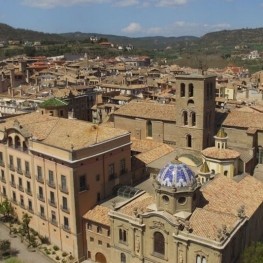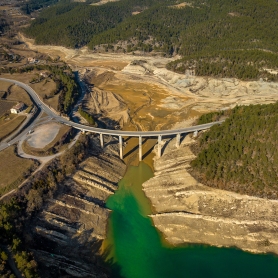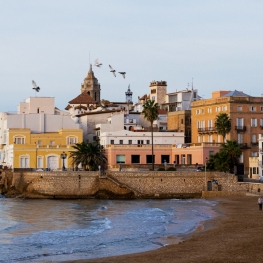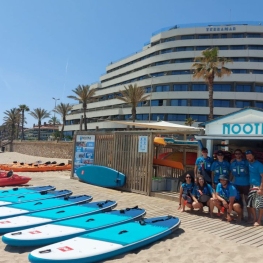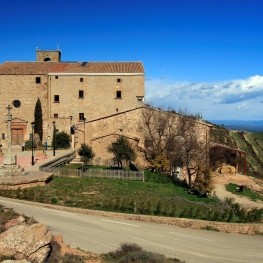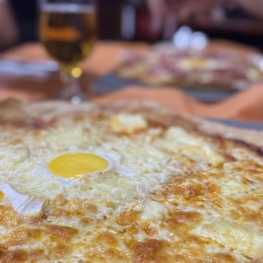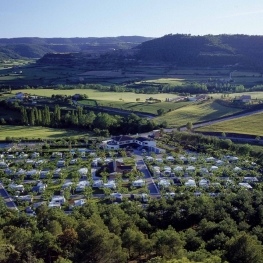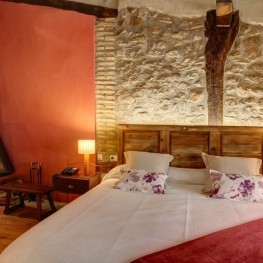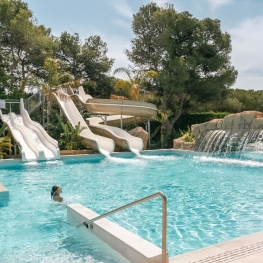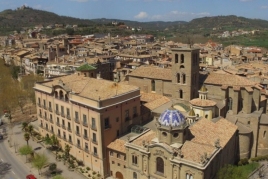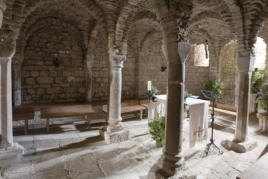The origin of Carnival
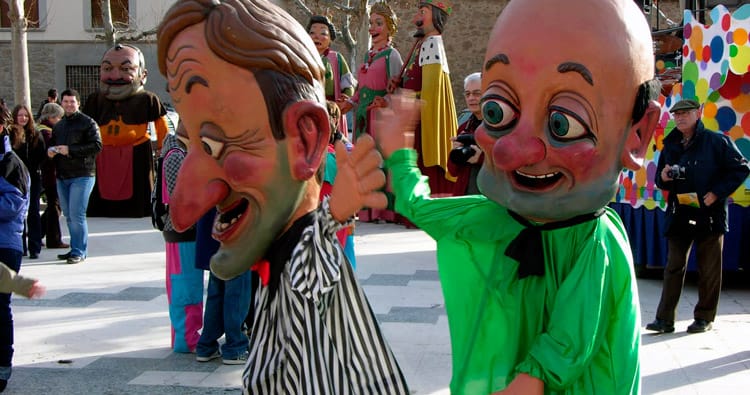
From femturisme we want to encourage you to participate in some of the most traditional carnivals that exist in Catalonia, in which mockery and criticism are the main course of the party. We are talking about the Carnival of Vilanova i la Geltrú and that of Solsona.
Go and do not miss it!
The carnival, also known in Catalonia as the " carnestoltes ", is a festival that is celebrated during a few days of this month, although its dates vary according to the year depending on the lunar calendar. Exactly, the Dijous Gras marks the beginning and it is celebrated until Wednesday of ash, that marks the end of this celebration and the beginning of the Lent.
It's a party of transgression and fun. People dress up, dance, sing... although according to the municipality you can live in different ways.
The origin of this Fiesta
 The carnival has its origin in a pagan festival, which sought to get rid of those deprivations that came accompanied with the Lenten period, which was characterized by hardness, repression and sacrifice. Therefore, people did what could not be done in the following days, for example, in Christianity, during Friday of Lent it was forbidden to eat meat.
The carnival has its origin in a pagan festival, which sought to get rid of those deprivations that came accompanied with the Lenten period, which was characterized by hardness, repression and sacrifice. Therefore, people did what could not be done in the following days, for example, in Christianity, during Friday of Lent it was forbidden to eat meat.
There are theories of some scholars who think that the name of carnival can derive from " carru navilis ", a ship that transported the bacchanalia. A bacchanal was a Roman cult to the gods Dionysius / Bacchus, god of wine, where he broke unrestrainedly with the conventionalism and formality of the time. And, consequently, it is believed that this festival can have its origins in this Greek celebration, in the Roman saturnalia celebrations that celebrated the end of winter or, even, in festivities of the Egyptian era.
Nowadays, it is a party conceived as a fun; where madness, satire and fun are the main protagonists. People change their identity to transform and flee from their daily lives, at least, for a few hours. But they do it anonymously because they disguise themselves, use masks,... They even make jokes and criticisms through burlesque satires of what they do not like. If it is already said by the popular saying "Per Carnaval, tot s'hi val " (For Carnival, anything goes).
The most traditional Carnivals
 Carnival is a celebration that is celebrated all over the world: Brazil, Venice, Colombia, Cádiz, Tenerife,... but each of these celebrations differs from the rest.
Carnival is a celebration that is celebrated all over the world: Brazil, Venice, Colombia, Cádiz, Tenerife,... but each of these celebrations differs from the rest.
Currently, in Catalonia we can group the carnival into two types. The carnival influenced by the Brazilian party; where music, dances and costumes are more important, as is the case of the well-known Sitges carnival. And the most traditional carnivals that place greater emphasis on satire, as is the case of Vilanova i la Geltrú and Solsona. One has adopted one more aspect of lucimiento and the other one of mockery and criticism. However, both in the satirical carnival and the show, appears the presence of a character known as the " King Carnestoltes ", which receives different names according to the people. This is who governs the municipality during the days of this celebration.
Vilanova i la Geltrú, a reference
 In Vilanova i la Geltrú this festival has been celebrated for many years. In fact, when General Franco banned the carnival in all the Spanish state, the year 1939, Vilanova i la Geltrú continued to celebrate it anyway, although it did so discreetly. However, from the year 1976 it resurged in all its splendor.
In Vilanova i la Geltrú this festival has been celebrated for many years. In fact, when General Franco banned the carnival in all the Spanish state, the year 1939, Vilanova i la Geltrú continued to celebrate it anyway, although it did so discreetly. However, from the year 1976 it resurged in all its splendor.
Perhaps for its perseverance, this carnival was declared in 1985 a traditional festival of national interest by the Generalitat de Catalunya.
The Vilanova carnival begins, every year, the Gras said with the xatonada, which ends with a merengue war and the Shawl dance. Continue on Friday with the Arrivo. This is the moment in which the king arrives carnestoltes and reads the Sermon, among them the sermon of the vilanoví Arrivo that in a satirical and burlesque version tells what is happening in Vilanova.
Saturday is the day that the character of Moixó Foguer appears, which is the costume of a bird covered in honey and feathers.
Carnival Sunday is notable for the parade of comparsas and the candy war. Throughout this day the boys of the municipality usually go dressed in a barretina and the girls with a Manila tablecloth.
Monday is the time for the " carnestoltes " choirs, which are a group of singers who play well-known melodies with personalized lyrics.
And the next day, on Tuesday, appears the comparsa of Vidalot. The Vidalot is like a kind of king of the carnestoltes that couples pairs of lots and in an arbitrary way looking for morbidity and expectation. The comparsa that accompanies it scares those who are left speechless.
All these days you can not live without going to the rhythm of the carnival hymn of Vilanova, the " Turuta ".
The relevance of this party in Solsona
The case of Solsona carnestoltes is different from that of Vilanova. This was stopped celebrating after the ban of this celebrity in 1939 and did not recover again until 1971, after 35 years. However, it was still a scandal. In the press it was titled as " the happy subversion of a town with an episcopal seat ".
 Seven years later (1978) the revival of the Carnival of Solsona was granted to him, the title of festivity of national tourist interest. And to this day, it has become one of the most typical and important celebrations of the municipality.
Seven years later (1978) the revival of the Carnival of Solsona was granted to him, the title of festivity of national tourist interest. And to this day, it has become one of the most typical and important celebrations of the municipality.
One of the most outstanding acts of Solsona's carnestoltes, which was controversial at the time, is the hanging of donkeys. Donkey donkeys are hung by the neck, which symbolize the legend where the reason why the Solsonians are called mataburros is explained, as these animals were tied by the neck in order to eat the herbs that grew in them. the belfry of the Tower of the hours, the poor beast, when he was dying, his bladder was emptying. Also, this false donkey let water go and wet all the assistants. This act takes place on Saturday with the well-known Carnival market.
The previous days the Sopar Gras and the deaf music concert are celebrated, a parade through the town with all kinds of instruments (lids, pots,...) that make noise. The two are made on fatty Thursday.
On Friday takes place the Cursa de Boits and the dance of the patacada in the main square. And on Sunday, at nine in the morning, the scalded soup is distributed, which is used to gather strength to participate in the dance of the blanched ones.
 Also during these days is the typical distribution of figs, coca and white wine, which takes place throughout the town and where in its squares is sung and danced, which allows to know the entire municipality through its route.
Also during these days is the typical distribution of figs, coca and white wine, which takes place throughout the town and where in its squares is sung and danced, which allows to know the entire municipality through its route.
Other emblematic characters of this party are the crazy giants. These are like a kind of meaty kings who deal blows with their arms and who are built, especially for this occasion. These, like all the carnival, dance to the rhythm of the double step " El bufi ".
Finally, it should be added that in this Carnival of Solsona the comparsas that participate do not use costumes since everyone is dressed in different colored gowns to differentiate one from the other. As you can see, it is an unusual carnival to which we are accustomed.
What to do
Solsona Experience, descobreix el Solsonès
SolsonaExperiential guided tours of the Solsonès region for all audiences, groups and…
Nootka Kayak & Sup
Sitges (a 5.2 Km)Nootka Jayak & Sup offers you different activities and guided excursions so…
Where to eat
Hostal de Pinós
Pinós (a 18.9 Km)It is the oldest restaurant in Catalonia that has never closed its…
Bar Restaurant Xato
Gironella (a 30 Km)Order pizzas, burgers, tapas... at Xato Bar-Restaurant and we'll deliver them to…
Taverna de La Vansa
La Vansa i Fórnols (a 26.5 Km)A self-managed mountain tavern in Espai La Vansa, ideal for enjoying local…
Bodega Miquel Jané
Font-rubí (a 23.3 Km)Discover the world of wine with our comprehensive viticulture and oenology courses,…
Where to sleep
Càmping el Solsonès
Solsona (a 1.8 Km)Camping El Solsonès offers fully equipped wooden bungalows, a new camping area,…
Hotel La Freixera
SolsonaDiscover Hotel la Freixera, a charming boutique hotel located in the middle…
Garrofer Green Camping
Sitges (a 4.7 Km)Come to Garrofer Green Camping and enjoy a unique vacation in a…
La Torreta d'Olius
Olius (a 3.9 Km)Enjoy an authentic Catalan farmhouse, which was documented in the year 900…


